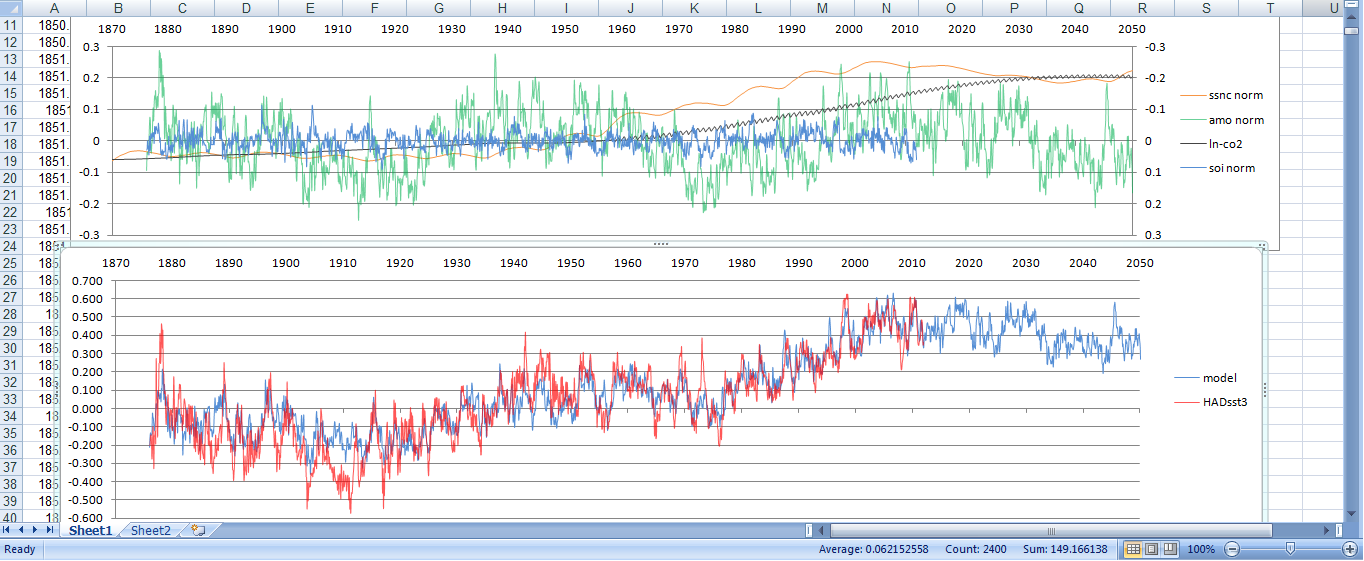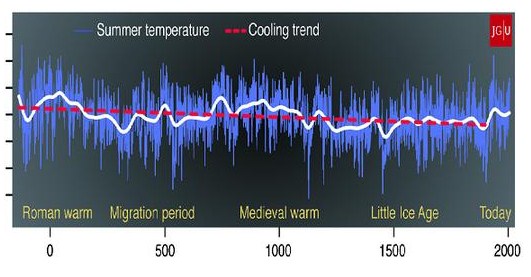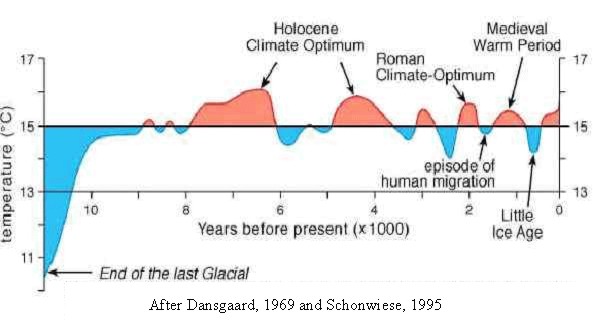Page's prediction is based on observation of the geologic record. He notes that there has been no net warming since 1997 even thought carbon dioxide content of the atmosphere has risen 8.5%. Page says that atmospheric temperature is driven by sea surface temperature (SST) which is, itself, solar driven. The oceanic oscillations control the general climate.
There is good correlation between solar cycles and SST, but note that because of the enthalpy and thermal inertia of the oceans, there is a 10 - 12 year lag between solar cycle troughs and global SSTs. This lag time definitely establishes cause and effect similar to the lag in carbon dioxide changes following temperature changes in the major glacial cycles as shown in ice cores The graph below shows the variations in the Pacific Decadal Oscillation (PDO), the major oceanic oscillation (the red line is actual measurement, the blue line is predictive modeling.) (Graph source here.)
Page says than in the figure "an approximate 60 year cycle is obvious by inspection and this coincides well with the 30 year +/- positive (warm) and 30year +/- negative (cold) phases of the Pacific Decadal Oscillation." The graph "shows warming from about 1910 to 1940-45, cooling from then to about 1975, warming to about 2003-5 and cooling since then. Total warming during the 20th century was about 0.8 degrees C." He also says that it is clear that we are entering the beginning of a 30-year cool phase of the PDO.
Page goes on to say:
"The major ice age climate cycles are controlled by the sun - earth orbital eccentricity, and the earth's obliquity and precession. These cycles are approximately 100,000, 41,000 and 21,000 years in length respectively and are well documented in the ice core and geological record. It is useful to keep in mind that the warmest temperatures in the current interglacial occurred about 7500+/- years ago and the general trend is now a cooling towards the next ice age."These cycles are shown in the 2,000-year temperature reconstruction below (the white line is the smoothed curve):
"These long term cycles are modulated by quasi cyclic trends in solar activity which may be decadal, centennial, or millennial in length. Of particular interest in deciding where we are with regard to the solar cycles is the approximately 1000 +/- year cycle which produced successively the Roman Warm Period, the Dark Ages, the Medieval Warm Period, the Little Ice Age and the recent 20th century warming."
Page says that "A reasonable case can be made that the warming peaks of a 60 year PDO cycle and the 1000 year solar cycle coincided at 2000 +/- and we are likely on the cooling slope of both."
For a broader view, the graph below shows a temperature reconstruction for the past 11,000 years:
In his conclusion, Page says "Often the signal for a climate direction change is a see-saw effect between Arctic and Antarctic sea ice. The Arctic is still reflecting the peak in the warming trend with low summer ice values. The first indication of a cooling event is however the increase in Antarctic sea ice which has already occurred." (See my post: The Arctic-Antarctic seesaw)
Page is not alone is his prediction. Two years ago I reported that NASA was also predicting a cooling period based on the same natural parameters. (See NASA Says Earth Is Entering A Cooling Period).
If this predicted cooling trend comes to pass, it will show, once again, that the forces of natural variation easily overcome the weak warming effect of carbon dioxide. And, by the way, if indeed the predicted cooling trend proceeds, atmospheric carbon dioxide will decrease because a cooler ocean can absorb more carbon dioxide.
This phase shift has some policy implications. It shows that curbing carbon dioxide emissions from burning fossil fuels is unnecessary and perhaps contraindicated. If you believe that such emissions do have a significant effect on global temperature, we should continue and perhaps even increase emissions to forestall or lessen the effect of the cooling trend lest we find ourselves in another "little ice age."






Reader Comments
to our Newsletter